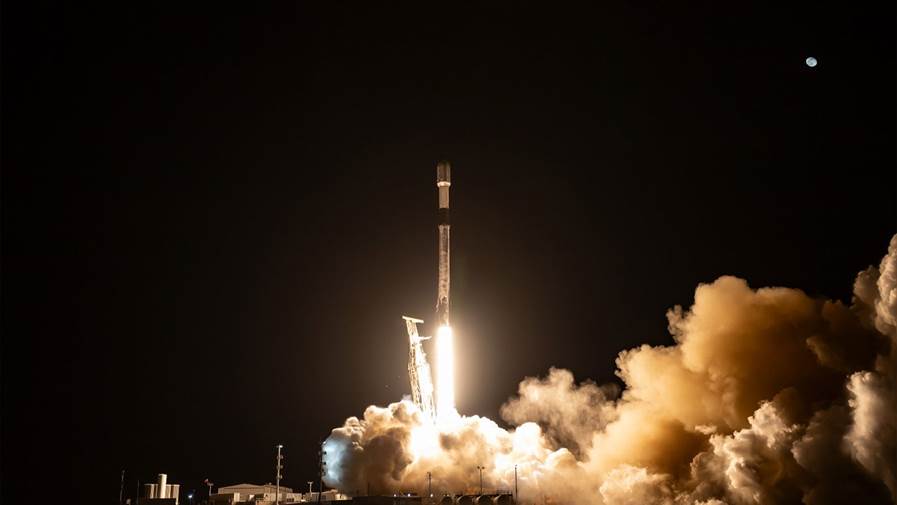SpaceX Launches 20 Spare Satellites to Enhance Eutelsat’s LEO Broadband Network
In a significant advancement for satellite broadband networks, SpaceX successfully launched 20 spare OneWeb satellites on October 20, 2023. This mission aims to bolster the resilience of Eutelsat’s low Earth orbit (LEO) broadband network. Eutelsat, a prominent French operator, is in direct competition with SpaceX’s Starlink in the race to provide comprehensive global internet coverage.
Eutelsat has confirmed that they made successful contact with each satellite after the launch, which took place at 1:13 a.m. Eastern Time from the Vandenberg Space Force Base in California, aboard a Falcon 9 rocket. This milestone adds to the constellation, bringing the total number of satellites in orbit to 654. Despite having an adequate number of satellites already in low Earth orbit to ensure worldwide coverage, Eutelsat’s progress has been somewhat delayed due to setbacks in ground infrastructure development.
Current Status and Future Plans
Katie Dowd, a spokesperson for Eutelsat, assured that the company is on schedule to commence global services by spring. The newly launched satellites are identical to those in OneWeb’s initial constellation. These satellites were predominantly manufactured by Airbus U.S. Space & Defense at their large-scale production facility in Merritt Island, Florida.
Eutelsat operates a diverse fleet, including 36 geostationary satellites. However, the company has not yet disclosed when it plans to deploy LEO satellites with upgraded technology. Instead, they have chosen a phased approach for the next-generation constellation. This strategy involves gradually introducing advanced technology over time.
According to Dowd, Eutelsat foresees the de-orbiting of the first generation of OneWeb satellites in the coming years as these spacecraft approach the end of their operational lifespans. Despite this, the company is considering options to extend the life of these satellites to ensure consistent service for their customers while transitioning to next-generation technology.
SpaceX’s Continued Success and Starlink’s Expansion
The launch also marked another successful recovery of the Falcon 9’s first-stage booster, which landed safely at Vandenberg less than eight minutes post-launch. This achievement adds to SpaceX’s impressive track record, marking the 357th successful recovery of an orbital-class booster.
SpaceX, a dominant player in the LEO satellite market, has launched over 7,000 broadband satellites for its Starlink network. Recently, Starlink reached a significant milestone with over four million subscribers. This network is rapidly expanding, aiming to provide high-speed internet across the globe, particularly in remote and underserved areas.
Competitive Landscape: Eutelsat and Others
Eutelsat, alongside other traditional geostationary satellite operators, is striving to harness the flexibility and resilience offered by a multi-orbit network. The goal is to remain competitive against Starlink, particularly in the enterprise and government sectors. Multi-orbit networks, which combine geostationary and LEO satellites, offer enhanced coverage and redundancy, making them attractive for various applications.
The competition in satellite broadband is intensifying as more players enter the market. Each company is leveraging its unique strengths, whether it be technological innovation, strategic partnerships, or operational efficiency, to capture a share of this growing industry.
Understanding the Technology
To better understand the significance of these developments, it’s essential to grasp some key concepts. Low Earth orbit (LEO) satellites operate at altitudes between 200 to 2,000 kilometers above the Earth. This proximity allows for lower latency, which is the time it takes for data to travel from the user to the satellite and back. Lower latency is crucial for applications requiring real-time data transmission, such as video conferencing or online gaming.
Geostationary satellites, on the other hand, orbit at much higher altitudes (about 35,786 kilometers) and remain fixed above a specific point on the Earth’s surface. While they provide wider coverage, the distance can result in higher latency, which may not be suitable for all internet applications.
The Future of Satellite Broadband
As satellite technology continues to evolve, the future of global internet connectivity looks promising. The ability to provide high-speed internet to remote and rural areas can have transformative effects on education, healthcare, and economic development. With companies like Eutelsat and SpaceX leading the charge, the digital divide may soon become a thing of the past.
Moreover, the advancements in satellite technology have broader implications for other industries, including aviation, maritime, and disaster response. Reliable and fast internet connectivity can enhance communication and operational efficiency in these sectors.
Conclusion
The recent launch of OneWeb satellites by SpaceX is a testament to the rapid progress and innovation in the satellite broadband industry. As Eutelsat prepares to roll out its global services, the competition with Starlink and other operators will likely drive further advancements and improvements in technology and service delivery.
For those interested in the latest developments in satellite technology and its implications on global connectivity, this launch represents a pivotal moment in the ongoing quest to connect the world. The continued expansion and enhancement of satellite networks promise to bring unprecedented levels of connectivity to every corner of the globe.
For further details and updates on similar topics, you may refer to reputable sources such as SpaceNews at spacenews.com.
For more Information, Refer to this article.


































